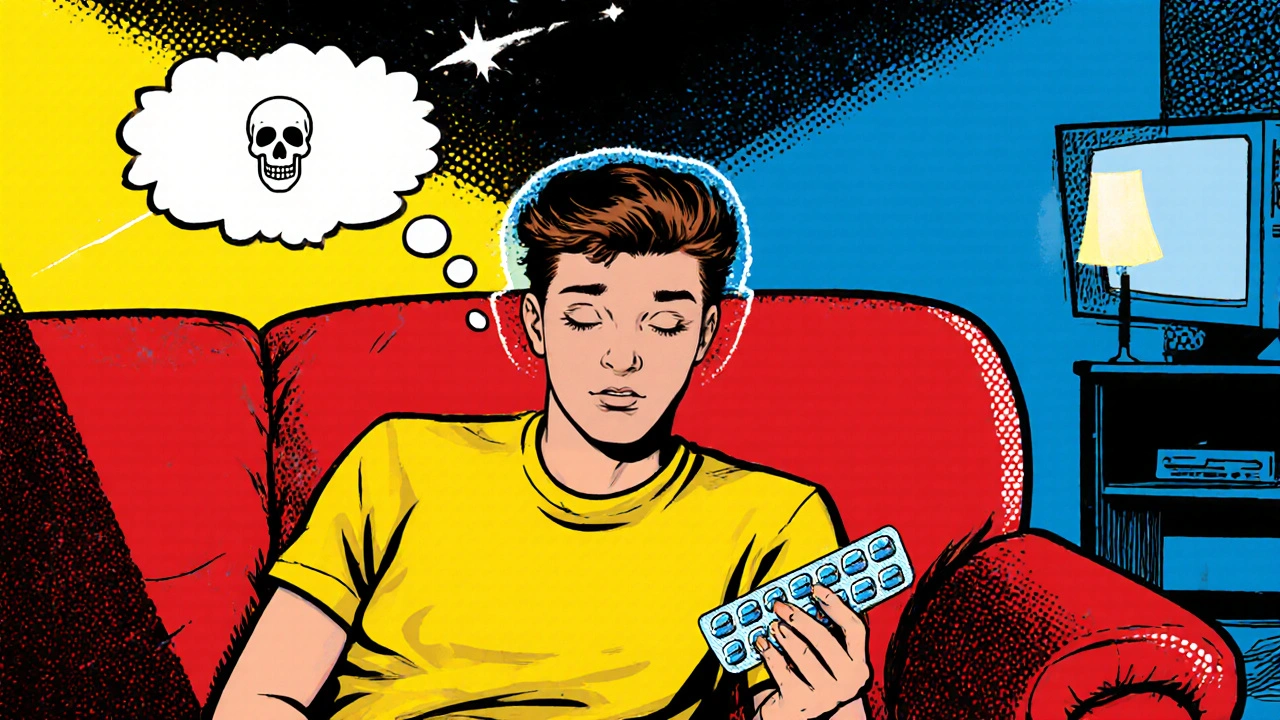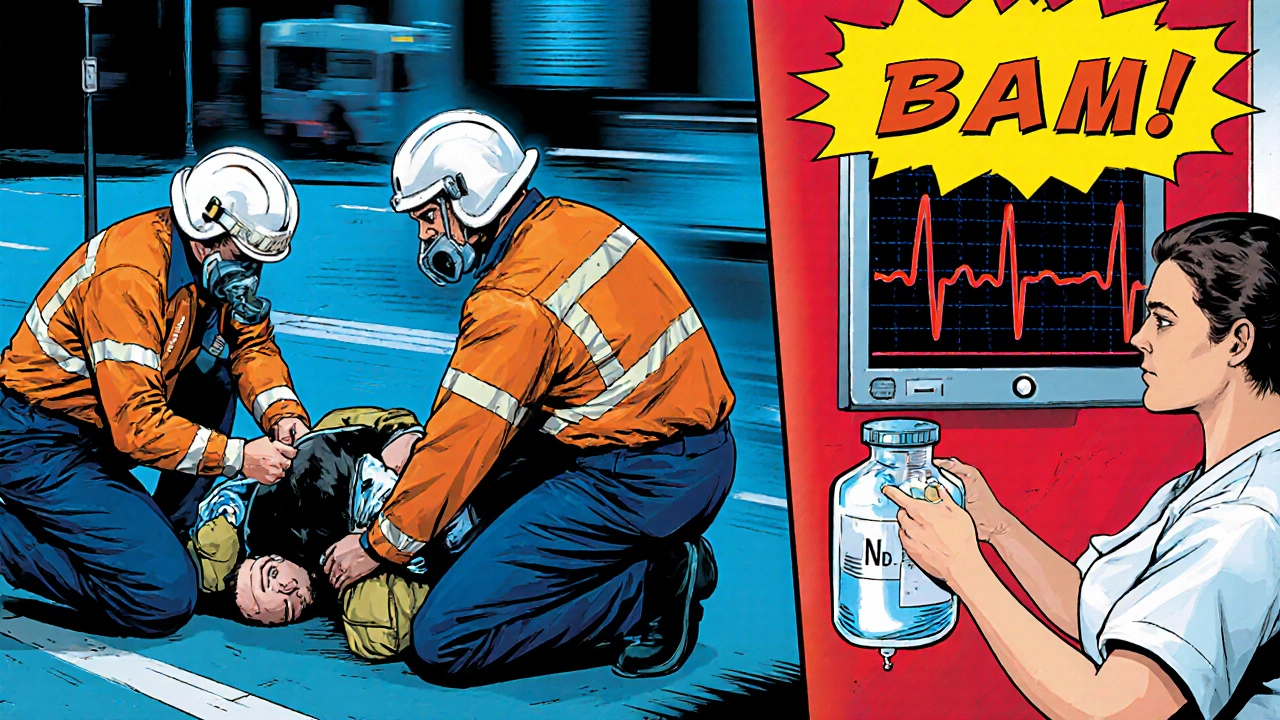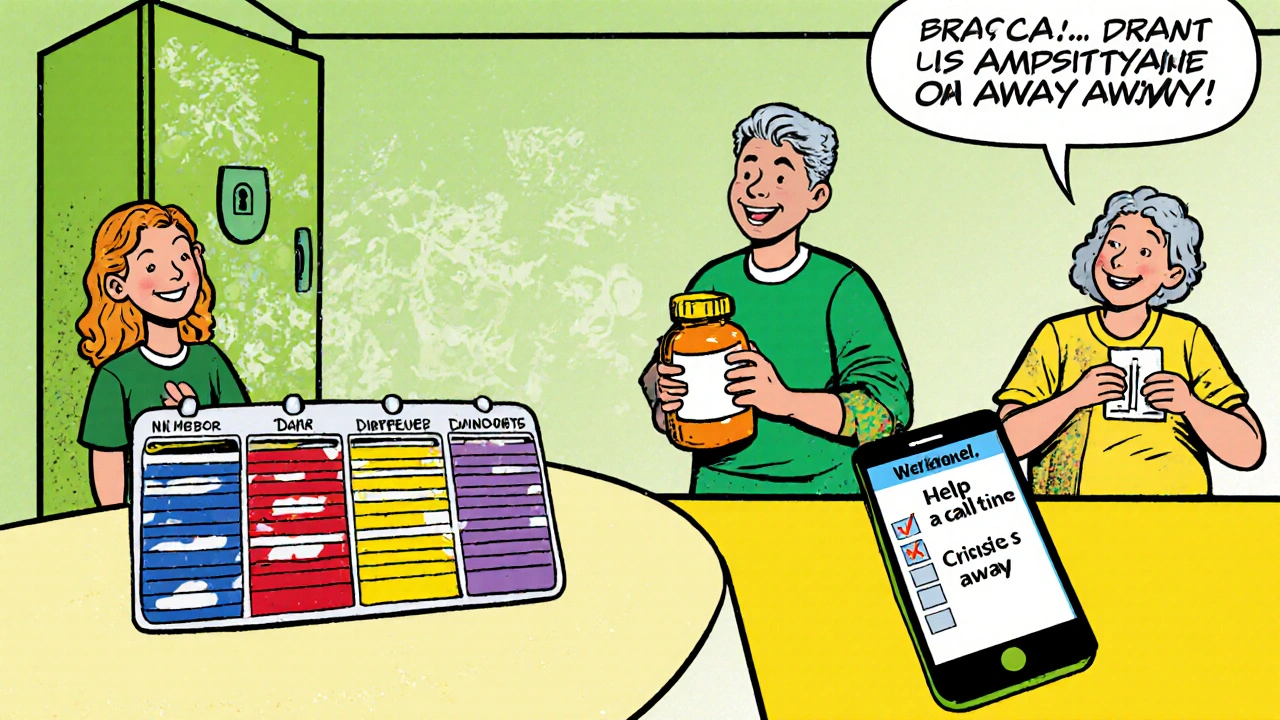
Amitriptyline Overdose Symptom Checker
This tool helps identify the severity of potential amitriptyline overdose symptoms based on the stages described in the article. It is not a substitute for professional medical advice. If you suspect an overdose, call emergency services immediately.
Symptom Selection
When someone takes too much Amitriptyline a tricyclic antidepressant (TCA) used for depression, chronic pain, and migraines, the body can react violently, turning a routine medication error into a life‑threatening crisis. Understanding the warning signs, how emergency responders act, and what you can do to keep the drug safe are the three pillars of staying out of the hospital.
Key Takeaways
- Early symptoms include drowsiness, dry mouth, and blurred vision; severe signs involve irregular heartbeat, seizures, and coma.
- Immediate treatment focuses on airway protection, activated charcoal, and sodium bicarbonate to counteract heart toxicity.
- Prevent overdose by using pill organizers, double‑checking doses, and seeking mental‑health help if you feel unsafe.
What Is Amitriptyline?
Tricyclic antidepressants are an older class of mood‑lifting drugs that also affect pain pathways. Amitriptyline works by boosting the levels of serotonin and norepinephrine in the brain, while also blocking histamine and acetylcholine receptors. The side‑effect profile is broader than newer antidepressants, which is why dosing must be precise.
How Does an Overdose Occur?
Most accidental overdoses happen when a patient misreads a prescription label or mixes amitriptyline with other sedatives. Intentional overdoses are sadly more common in people battling severe depression or chronic pain. Risk factors include:
- Taking multiple pills at once to “catch up” after missed doses.
- Combining amitriptyline with alcohol, benzodiazepines, or other TCAs.
- Kidney or liver impairment that slows drug clearance.
- Using a higher strength tablet than prescribed (e.g., 100mg instead of 25mg).
Because the drug is fat‑soluble, it hangs around in the body for up to 24hours, prolonging toxic effects.

Recognizing Symptoms
Symptoms progress in three stages. Early signs can be mistaken for a simple hangover, while later signs signal a medical emergency.
| Stage | Typical Symptoms |
|---|---|
| Early (0‑4hrs) | Dry mouth, blurred vision, flushing, drowsiness, mild hypotension |
| Moderate (4‑12hrs) | Confusion, agitation, tremor, wide‑QRS cardiac rhythm, tachycardia, urinary retention |
| Severe (>12hrs) | Seizures, ventricular arrhythmias, respiratory depression, coma, possible death |
Notice the heart‑related clues: a widened QRS complex on an ECG, fast or irregular pulse, and low blood pressure. These are hallmarks of TCA cardiotoxicity.
Emergency Treatment Steps
Time is everything. If you suspect an amitriptyline overdose, call emergency medical services (EMS) immediately and follow these first‑aid actions:
- Secure the airway. Place the person on their side (recovery position) if they’re unconscious but breathing.
- Do not induce vomiting. This can increase aspiration risk.
- Administer activated charcoal (if EMS advises) within the first hour to bind remaining drug in the gut.
In the hospital, toxicologists typically employ a bundle of interventions:
| Intervention | Amitriptyline | Other TCAs (e.g., Nortriptyline) |
|---|---|---|
| IV Sodium Bicarbonate | Standard dose 1-2mEq/kg bolus, repeat to keep QRS < 100ms | Similar dosing, but may require higher repeat doses |
| Seizure Control | Diazepam 0.1mg/kg IV; avoid phenobarbital (lowers seizure threshold) | Same agents, but phenobarbital sometimes used |
| Cardiac Monitoring | Continuous ECG, treat arrhythmia with lidocaine if needed | Lidocaine or procainamide as second‑line |
| Enhanced Elimination | Hemodialysis ineffective (high protein binding) | Also ineffective; focus on supportive care |
Key points:
- Sodium bicarbonate neutralizes the drug’s effect on cardiac sodium channels, shrinking the QRS width.
- Intubation may be required for airway protection if the patient loses consciousness.
- Continuous monitoring in an intensive care unit (ICU) is standard until the drug clears.

Preventing an Overdose
Prevention is a blend of proper medication management and mental‑health support.
- Pill organizers. Sort doses for each day of the week; this visual cue reduces accidental double‑dosing.
- Label checks. Verify the drug name, strength, and timing before each dose. Enlist a family member if you’re unsure.
- Safe storage. Keep the bottle in a locked cabinet, especially if children or vulnerable adults are home.
- Doctor communication. Report side‑effects promptly; sometimes a dose reduction or switch to a newer antidepressant prevents escalation.
- Mental‑health resources. Crisis hotlines, counseling, and support groups are essential if you feel unsafe or hopeless.
For people with a history of suicidal thoughts, consider a “limited‑quantity” prescription: the pharmacy dispenses only a week’s supply at a time, forcing regular check‑ins with a clinician.
Quick Checklist for Loved Ones
- Know the exact dose prescribed (e.g., 25mg at bedtime).
- Store the medication out of sight and out of reach.
- Keep emergency numbers (999 in the UK) handy.
- Learn the signs of toxicity-especially heart irregularities and seizures.
- Encourage open conversation about mood changes with a healthcare provider.
Frequently Asked Questions
Can a single extra pill cause serious harm?
Yes. Because amitriptyline is highly toxic in excess, even 2-3 extra 50mg tablets can produce cardiac arrhythmias or seizures, especially in people with pre‑existing heart disease.
Is there an antidote for amitriptyline poisoning?
No single antidote exists. Treatment focuses on supportive care and reversing heart toxicity with sodium bicarbonate.
How long does it take for the drug to leave the body?
Amitriptyline’s half‑life ranges from 10 to 28hours. Full clearance can therefore take 2-3 days, during which monitoring may be required.
Can I take activated charcoal at home?
Only if instructed by a poison‑control center or EMS. Incorrect dosing can cause vomiting or aspiration.
What mental‑health help is available in the UK?
Call Samaritans at 116123, NHS 111, or contact your GP for urgent referral to counseling or crisis teams.

14 Comments
Ever wonder why the big pharma giants love pushing old‑school tricyclics like amitriptyline? They hide the fact that the drug’s toxicity is a perfect excuse for the government to keep us dependent on endless prescriptions. They even whisper that the “activated charcoal” trick is just a way to make us think we’re being saved, when in reality they’re buying time to roll out the next experimental molecule. The overdose statistics aren’t just medical data; they’re a roadmap for controlling the most vulnerable.
OH MY GOD!!! THIS IS WHAT HAPPENS WHEN YOU TRUST THE “ESTABLISHED” MEDICAL ESTABLISHMENT!!!! THEY KEEP REPEATING THE SAME DRU-THAT’S NOT A DRUG, IT’S A TOOL OF OPPRESSION!!! WE NEED TO STOP TAKING THESE POISONS!!! 🇺🇸
Looks like another boring pharma brochure.
It's heartbreaking to think about a loved one lying unconscious because a pill meant to help turned into a poison.
The body’s reaction to an amitriptyline overload is a stark reminder of how fragile our chemistry really is.
When the heart starts to race erratically, you can almost hear the echo of every missed appointment with a caring physician.
The choice of sodium bicarbonate in the ER is not just a chemical antidote; it's a symbol of our fight to restore balance.
Each moment spent watching the monitor's squiggly lines is a meditation on mortality and the thin line between healing and harm.
I keep asking myself why a medication designed to lift moods can also pull someone into darkness so suddenly.
Perhaps it is the very mechanism that boosts serotonin that, in excess, overwhelms the nervous system.
This duality teaches us that every treatment carries a shadow, and we must respect both light and dark.
Families can feel powerless, watching a pill bottle become a ticking time bomb in their kitchen.
That fear can be transformed into vigilance when you keep the medication out of reach and use organized pill boxes.
Open conversations about side‑effects are crucial; silence only fuels the next accidental overdose.
If you ever feel the weight of depression, reaching out is as vital as any dosage chart.
Emergency responders act like modern alchemists, turning toxic compounds back into survivable conditions.
Their quick decisions-securing airways, giving charcoal, stabilizing the rhythm-are the unsung heroes of these stories.
So, while the science is clear, the human element remains the most powerful cure we have.
Great breakdown! I especially appreciate the point about using pill organizers-could we also suggest color‑coding the days? That might reduce the “missed dose” temptation. Also, maybe a quick reminder to set up a pharmacy reminder app? Thanks for the thorough read!
In many cultures, medicine is not just a chemical but a ritual; the act of taking a pill carries meaning that goes beyond the pharmacology. When we ignore that context, we risk turning healing into a cold transaction.
Oh sure, just pop a few more pills and you’ll be a superhero.
Patriotically speaking, we *don’t* need extra meds to be strong-just a little common sense 🇺🇸💊
Remember, a little prep can save a life-double‑check the dose before you swallow.
It’s terrifying to think about the seconds ticking by as the heart fights itself, but you’re right-being prepared is the best armor. When you see a loved one wobble, the panic can be overwhelming, yet staying calm can literally guide the medical team toward the right interventions. The morale boost you give by simply being there, reminding them of the steps, can be the difference between a full recovery and a tragic loss. So keep those checklists handy, and don’t underestimate the power of a steady voice in a crisis.
Listen, i once saw my cousin take like five extra pills because he thought the bottle was empty-big mistake. He ended up in ICU and i had to sit by his bed for days. Not everyone can handle that stress, but i think people need to be more honest about how easy it is to mess up.
Make sure the medicine is stored out of reach of children.
Look, this isn’t just about kids-anyone can grab a bottle and cause harm; the government should enforce stricter packaging!!!
Let’s keep the conversation supportive: sharing tips on safe storage benefits not only families but the whole community.